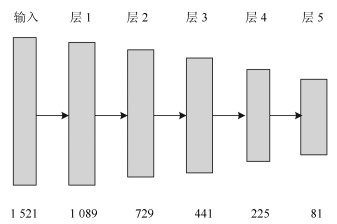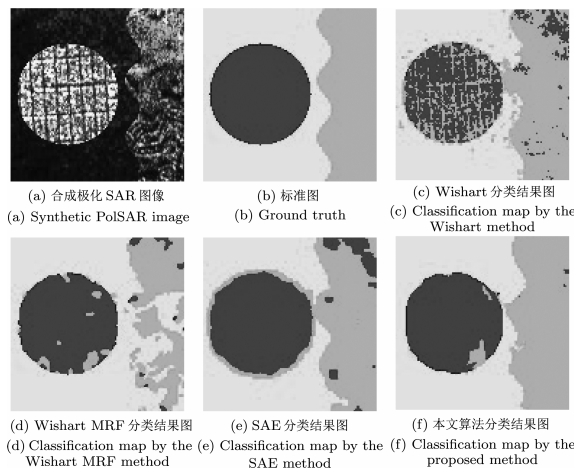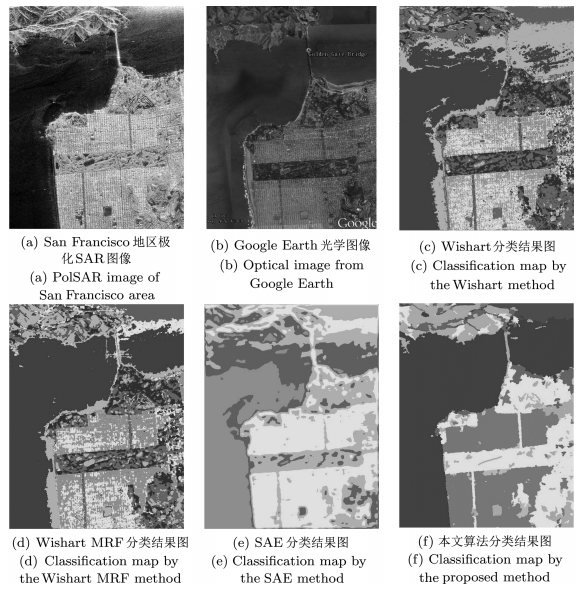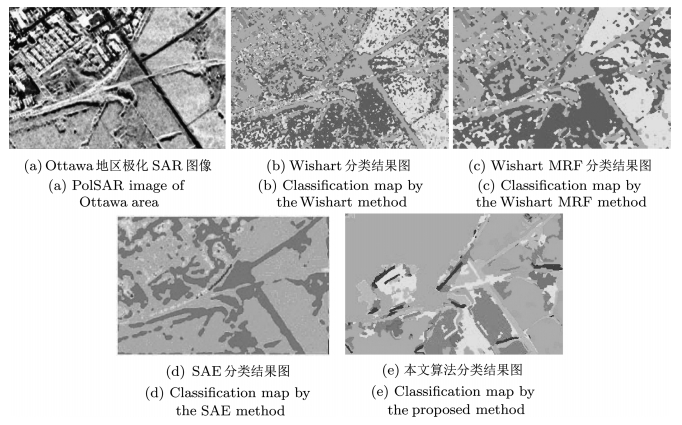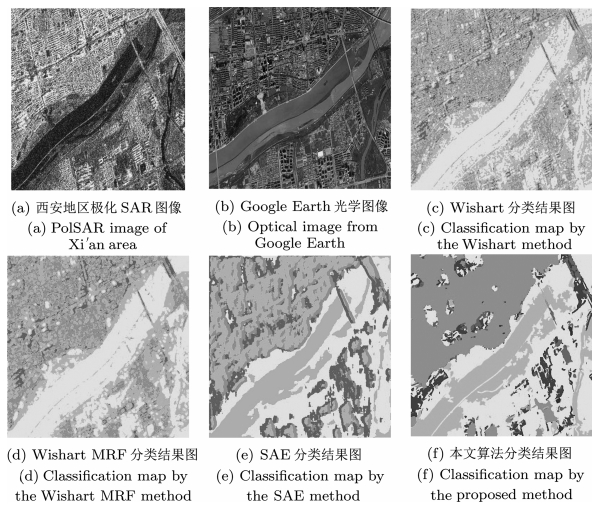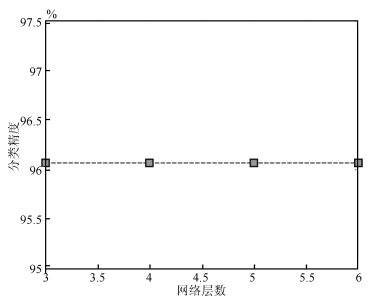Polarimetric SAR Image Classification Based on Deep Learning and Hierarchical Semantic Model
-
摘要: 针对复杂场景的极化合成孔径雷达(Synthetic aperture radar,SAR)图像,堆叠自编码模型能够自动学习高层特性,有效表示城区、森林等复杂地物的结构,然而,却难以保持图像的边界和细节.为了克服该缺点,本文结合深度自编码器和极化层次语义模型(Polarimetric hierarchical semantic model,PHSM),提出了新的无监督的极化SAR图像分类算法.该方法根据极化层次语义模型,将复杂的极化SAR图像划分为聚集、匀质和结构三大区域.对聚集区域,采用堆叠自编码模型进行高层特征表示,并构造字典得到稀疏特征进行分类;对匀质区域,采用层次模型进行分类;对于结构区域,进行线目标保留和边界定位.实验结果表明,该算法通过不同的分类策略优势互补,能够得到区域一致性好且边界保持的分类结果.Abstract: Stacked auto-encoder model can effectively represent the complex terrain structures, such as the urban and the forest, by automatically learning high-level features. However, it has difficulty in preserving details and edges. In order to overcome this shortcoming, a new unsupervised polarimetric synthetic aperture radar (PolSAR) classification method is proposed by combining the deep learning and the polarimetric hierarchical semantic model (PHSM). According to the PHSM, a PolSAR image is partitioned into aggregated, homogeneous and structural regions. For aggregated regions, a stacked auto-encoder model is applied to learn high-level features, and further the sparse representation and classification is constructed by learning a dictionary with high-level features. For homogeneous regions, hierarchical segmentation and classification is applied. In addition, edges are located and line objects are preserved for structural regions. Experimental results demonstrate that the proposed method can obtain good performance in both region homogeneity and edge preservation.
-
化工生产过程中对于生产运作的需求, 已从过去着重考虑系统的稳定性, 转变至兼顾系统安全稳定下同时优化全局系统运行的经济性.这里的经济性通常用一类定义在系统工作范围的经济指标(泛指一类评价系统运行状况的性能函数)评价, 全局优化运行的目标, 是使得系统实际闭环运行轨迹在允许的工作范围内, 同时尽可能减少各时刻工作状态对应的经济指标在整个生产过程的累积量.大型系统的全局优化常用分层递阶控制结构将生产中对于安全、鲁棒、经济等多目标逐层分解.实时优化层根据调度层的计划与排产信息, 从面向全局系统整体经济性的角度, 给出满足各子系统运行约束的稳态经济优化点.下层先进控制层常用MPC (Model predictive control)动态跟踪上层给出的稳态经济优化点, 综合处理系统运行过程中的约束与扰动, 并给底层各控制回路合适的设定值.同时, 新工业需求下的全局优化运行还要求系统在工作过程中, 对定制生产下不同排产计划、更小尺度的对象模型变化(如不同批次组分差异的原料、不同反应过程工况变化)都有对应的系统模式变化, 在这种情况下的全局优化问题可归结于讨论切换非线性系统在双层控制结构下的经济优化运行.
目前多数非线性系统全局优化运行的运作模式是建立在"稳态假设[1]基础上, 因此, 非线性系统模式切换的研究热点在于保证各个模式运行工作点的稳定性、鲁棒性及模式间的平稳过渡[2-6].其中, 由于控制时域受到计算负担限制, 不同模式下优化问题的可行域未必存在交集, 有一部分研究工作考虑限制计算量的情况下保证系统在大工作范围内切换可行性[7].新工业需求下, 系统频繁的切换使得"稳态假设"不能满足, 运行动态过程中的经济性变的不可忽略.近年来, 学者将经济预测控制[8-10] (Economic model predictive control, EMPC)运用到切换非线性系统中, 对于提高系统在整个运行过程中的经济性有显著贡献. EMPC是一种在形式上、运行策略上与实时求解的MPC相同的滚动时域控制算法, 其在每一时刻同样需实时求解一个有限时域最优控制问题.但EMPC的控制性能指标为直接与经济指标相关的广义性能指标, 正定性和(或)凸性不再保证.因此, 在讨论稳定性问题上, EMPC常常需要引入额外的假设条件或约束.常规的方法主要有以下两种:文献[8]中首次提出的耗散性条件通过构造关于经济性能指标、系统模型、稳态经济优化点的不等式约束关系, 构造了对应的Lyapunov函数, 从而保证稳态经济优化点的稳定性.以此假设为基础, 后续工作拓展至终端集约束EMPC[9]、无终端约束EMPC等[10]; 另一类方法通过构造辅助Lyapunov函数和(或) Lyapunov控制器, 将其作为约束放入控制率实时求解的问题中, 针对连续系统有文献[11-12], 离散系统有文献[13-14].该类方法在一定程度上增大算法吸引域, 但闭环系统的经济性能将受限于所构造的辅助控制器及辅助Lyapunov函数.
针对非线性切换系统的EMPC, 目前的工作在系统前后模式可行域存在交集的前提下, 保证了切换过程的平稳过渡并提高了经济性能[12, 15].文献[12]采用基于Lyapunov函数的EMPC, 每个模式下EMPC的吸引域为辅助控制器的可控集, 前后两个模式算法吸引域需存在交集; 文献[15]基于拓展时域终端集约束EMPC[16]的方式保证稳定性, 其前一模式下的稳态优化点需位于后一模式终端约束集中.受限于EMPC讨论稳定性的复杂性, 对于在大工作范围内的切换系统, 如何考虑过渡过程的经济性能并平稳切换, 还未有成熟的工作.
针对这一问题, 本文采取的思想是构造一系列可行中间过渡稳态点拓展前后模式的可行域, 通过设计局部EMPC控制器, 将状态逐次转移至中间点并完成切换.在这一策略下, 本文构造了基于耗散的EMPC辅助性能指标, 在辅助性能指标控制下的EMPC能够保证任一可行稳态点渐近稳定, 并尽可能逼近原经济性能指标; 进一步, 本文设计了对应的切换策略, 在模式常规运行时, 算法保证状态稳定在该模式的稳态经济优化点.同时, 在模式切换时根据前后模式的经济指标求解和更新可行中间点及最优轨迹, 将状态逐次转移至中间稳态点并利用最优轨迹保证状态在模式间的平稳过渡.所提方法适用于存在不可达问题的非线性切换系统, 实际可操作性强, 在保证平稳切换的基础上提高了暂态过程的经济性, 仿真结果验证了算法的有效性.
符号说明:集合 ${I}$ 表示非负整数集. ${S}_{ \ge a}$ 表示集合满足 $S_{ \ge a} = \{ x \in {S};x \ge a\} $ , 同样, ${S}_{[a, b]} = \{x \in {S};a \le x \le b\} $ , 其中 $a, b \in {I}$ . $\left| \cdot \right|$ 表示欧几里得范数. ${B_{{x^s}}}(r)$ 表示闭球域满足: ${B_{{x^s}}}(r):\{ {\pmb x}:|{\pmb x} - {{\pmb x}^s}| \le r\} $ . Class $\mathcal {L}$ 表示一类定义在 $\gamma :{{\bf{R}}_{ \ge 0}} \to {{\bf{R}}_{ \ge 0}}$ 上的连续且单调递减函数, 满足 $\mathop {\lim }_{x \to \infty } \gamma (x) = 0$ , $f\circ g(x)$ 表示复合函数 $f(g(x))$ .
1. 问题描述及基本定义
考虑如下非线性系统离散时间模型:
$ \begin{equation} {\pmb x}(k + 1) = {{\pmb f}_{\sigma (k)}}({\pmb x}(k), {\pmb u}(k)) \end{equation} $
(1) 其中, $k \in {{I}_{ \ge 0}}$ , ${\pmb x}(k) \in {{\bf{R}}^{{n_x}}}$ 表示状态变量, ${\pmb u}(k) \in {{\bf{R}}^{{n_u}}}$ 为输入变量.本文考虑的系统不限于离线规划好的有限个切换模式, 但所有模式具有相同的状态变量和输入变量维数, 并且切换的发生具有自主性.在切换发生前, 工作在原模式的系统从 $\tau $ 时刻接到切换请求, 到最迟允许发生切换, 具有准备时间 ${T_p}$ .如生产原料的批次更换、工况条件的改变、排产计划变化等不同工作任务下引起模型的变化.因此, $\sigma: [{k_0}, {k_1}) \to {I}_{ \ge 1}$ , $\sigma (k + 1) = \varphi (k, {\pmb x}(k), \sigma (k), \tau, {T_p})$ , 为与当前工作模式、系统状态及时间有关的函数.对于确定 $\sigma (k) = i$ 模式下, 模型为 ${{\pmb f}_i}({\pmb x}(k), {\pmb u}(k)):{{\bf{R}}^{{n_x}}} \times {{\bf{R}}^{{n_u}}} \to {{\bf{R}}^{{n_x}}}$ , 与生产目标对应的经济指标为 $l_e^i({\pmb x}(k), {\pmb u}(k)):{{\bf{R}}^{{n_x}}} \times {{\bf{R}}^{{n_u}}} \to {{\bf{R}}}$ .状态约束为 ${\pmb x}(k)\in{\mathcal {X}^i}$ , 输入约束为 ${\pmb u}(k)\in{\mathcal {U}^i}$ .
假设1. 经济性能指标 $l_e^i( \cdot )$ 在 ${{\bf{R}}^{{n_x}}} \times {{\bf{R}}^{{n_u}}}$ 上连续, 且各模式下模型 ${{\pmb f}_i}( \cdot )$ 在 ${\mathcal {X}^i} \times {\mathcal {U}^i}$ 上利普希茨连续, 满足:
$ \begin{equation} |{{\pmb f}_i}({{\pmb x}_1}, {{\pmb u}_1})- {{\pmb f}_i}({{\pmb x}_2}, {{\pmb u}_2})| \le L_{{f_x}}^i|{{\pmb x}_1}- {{\pmb x}_2}| + L_{{f_u}}^i|{{\pmb u}_1}- {{\pmb u}_2}| \end{equation} $
(2) 假设2. 模式 $i$ 下存在(但不唯一)稳态经济优化点 $({\pmb x}_i^*, {\pmb u}_i^*)$ 为如下问题的最优解, 不失一般性, $\bar l_e^i = l_e^i({\pmb x}_i^*, {\pmb u}_i^*) = 0$ .
$ \begin{equation} \begin{array}{*{20}{c}} {\min l_e^i({\pmb x}, {\pmb u})}&{{\rm s.t.}}&{{\pmb x} = {{\pmb f}_i}({\pmb x}, {\pmb u}), {\pmb x} \in {\mathcal {X}^{i}}, {\pmb u} \in {\mathcal {U}^{i}}} \end{array} \end{equation} $
(3) 定义1. 模式 $i$ 下的稳态点 $({\pmb x}_i^s, {\pmb u}_i^s)$ 的 $N$ 步可达状态集合为
$ \begin{align} &{\phi _i}({\pmb x}_i^s, N) = \{ {\pmb x}(N):\forall k \in {{I}_{[0, N-1]}}, \exists {\pmb u}(k) \in {\mathcal {U}^i}, \nonumber\\ &{\pmb x}(0) = {\pmb x}_i^s, {\pmb x}(k+1) = {{\pmb f}_i}({\pmb x}(k), {\pmb u}(k)), {\pmb x}(k) \in {\mathcal {X}^i}\} \end{align} $
(4) 定义2. $N$ 步可控至 $({\pmb x}_i^s, {\pmb u}_i^s)$ 的初始可行状态集合为
$ \begin{align} &{\psi _i}({\pmb x}_i^s, N) = \{ {\pmb x}(0):\forall k \in {{I}_{[0, N-1]}}, \exists {\pmb u}(k) \in {\mathcal {U}^i}, \nonumber\\ &{\pmb x}(N) = {\pmb x}_i^s, {\pmb x}(k+1) = {{\pmb f}_i}({\pmb x}(k), {\pmb u}(k)), {\pmb x}(k) \in {\mathcal {X}^i}\} \end{align} $
(5) 定义3. 模式 $i$ 下, 控制时域为 $N$ 时与稳态点 ${\pmb x}_i^s$ 相关的成对可行约束集定义为
$ \begin{align} &{Z^i}({\pmb x}_i^s) = \{ ({\pmb x}, {\pmb u}):{\pmb x} \in {\psi _i}({\pmb x}_i^s, N), \nonumber\\ &{\pmb u} \in {\mathcal {U}^i}, {{\pmb f}_i}({\pmb x}, {\pmb u}) \in { \psi _i}({\pmb x}_i^s, N)\} \end{align} $
(6) 假设3. 模式 $i$ 下对应的成对可行约束集均满足 ${Z^i}({\pmb x}_i^s) \ne \varnothing $ 且为紧集.
类似于多数EMPC文献[8-12]中关于系统实际运行经济性的定义, 对于每一模式确定的 $({\pmb x}_i^*, {\pmb u}_i^*)$ , 本文所考虑的切换系统暂态过程经济性(Transient performance)为下述形式:
$ \begin{align} J_i^S({{\pmb x}_\mu }(k), ~&{\pmb \mu }({\pmb x}(k)))=\nonumber\\ & - ({T_s} - {\tau _i})\bar l_e^i - ({\tau _{i + 1}} - {T_s})\bar l_e^{i + 1}+\nonumber\\ & \sum\limits_{k = {\tau _i}}^{{T_s} - 1} {l_e^i({{\pmb x}_\mu }(k), {\pmb \mu }({\pmb x}(k)} )) + \nonumber\\ & \sum\limits_{k = {T_s}}^{{\tau _{i + 1}} - 1} {l_e^{i + 1}({{\pmb x}_\mu }(k), {\pmb \mu }({\pmb x}(k))} ) \end{align} $
(7) 其中, $({{\pmb x}_\mu }(k), {\pmb \mu }({\pmb x}(k)))$ 表示系统实际状态轨迹, ${\tau _i}$ 表示系统在模式 $i$ 下偏离 $({\pmb x}_i^*, {\pmb u}_i^*)$ 的时刻, ${\tau _{i+1}}$ 表示在模式 $i+1$ 下稳定至 $({\pmb x}_{i{\rm{ + }}1}^*, {\pmb u}_{i+1}^*)$ 的时刻. ${T_s}$ 为发生切换的时刻, 满足 ${T_s} - {\tau _i} \le {T_p}$ .该性能指标理解为从 $i$ 模式至 $i+1$ 模式暂态过程状态偏离稳态优化点所损失的经济性能.
本文的目的是设计针对非线性切换系统全局优化运行的EMPC算法, 保证 $i$ 模式常规运行时系统稳定在指定的稳态目标优化点 $({\pmb x}_i^*, {\pmb u}_i^*)$ ; 模式间切换时保证系统平稳切换至新模式并提高暂态过程的经济性, 本文并不要求相邻模式间常规运行时EMPC算法吸引域存在交集, 仅要求在状态约束和输入约束范围内存在有限个控制时域可达集或可控集相交的中间稳态点, 满足如下假设.
假设4. 模式 $i$ 和 $i+1$ 下, 存在有限多个稳态点: $({\pmb x}_{i, 0}^s$ , ${\pmb u}_{i, 0}^s)$ , $({\pmb x}_{i, 1}^s$ , ${\pmb u}_{i, 1}^s)$ , $\cdots$ , $({\pmb x}_{i, {p_i}}^s$ , ${\pmb u}_{i, {p_i}}^s)$ ; $({\pmb x}_{i+1, 0}^s$ , ${\pmb u}_{i+1, 0}^s)$ , $({\pmb x}_{i+1, 1}^s$ , ${\pmb u}_{i+1, 1}^s)$ , $\cdots$ , $({\pmb x}_{i+1, {p_{i + 1}} }^s$ , ${\pmb u}_{i+1, {p_{i + 1}} }^s)$ .其中, ${\pmb x}_{i, 0}^s$ = ${\pmb x}_i^*$ , ${\pmb x}_{i + 1, {p_{i + 1}}}^s = {\pmb x}_{i + 1}^*$ .其余为中间稳态点, 且满足:
$ \begin{align} &{\pmb x}_{i, {p_i}}^s \in {\psi _{i{\rm{ + 1}}}}({\pmb x}_{i + 1, 0}^s, N), \nonumber\\ &{\pmb x}_{m, j}^s \in {\psi _m}({\pmb x}_{m, j+1}^s, N), \nonumber\\ &\forall j \in {{I}_{[0, {p_m}-1]}}, m = i, i + 1 \end{align} $
(8) 或可表述为
$ \begin{align} &{\pmb x}_{i, {p_i}}^s \in {\psi _{i + 1}}({\pmb x}_{i + 1, 0}^s, N), \nonumber\\ & {\pmb x}_{m, j{\rm{ + 1}}}^s \in {\phi _m}({\pmb x}_{m, j}^s, N), \nonumber\\ & \forall j \in {{I}_{[0, {p_m}-1]}}, m = i, i + 1 \end{align} $
(9) 注1. 假设4包括 ${\phi _i}({\pmb x}_i^*, N) \cap {\psi _{i + 1}}({\pmb x}_{i + 1}^*, N) = \varnothing $ 的情况, 大多数非特殊性连续化工切换系统在采样时间足够短的情况下, 其离散表述均能满足假设.
2. 基于耗散性条件的全局优化运行EMPC
对于具有稳态运行需求的化工过程, 需保证任一模式下的系统渐近稳定在稳态优化点 $({\pmb x}_i^*, {\pmb u}_i^*)$ .切换过程中, 由于控制时域 $N$ 受计算负担限制, 新模式的稳态点 $({\pmb x}_{i+1}^*, {\pmb u}_{i+1}^*)$ 对于旧模式当前状态常常是控制时域内不可达的, 即 ${\pmb x}_{i+1}^{\rm{*}} \notin {\phi _i}({\pmb x}_i^{\rm{*}}, N)$ 且 ${\pmb x}_i^{\rm{*}} \notin {\psi _{i+1}}({\pmb x}_{i+1}^{\rm{*}}, N)$ , 本文采取的策略如图 1所示, 首先, 该切换算法优化求解可行中间稳态点 $({\pmb x}_{m, j}^s, {\pmb u}_{m, j}^s)$ , 使其满足条件(8) 和(9).其次, 将状态依次经济转移至中间稳态点 $({\pmb x}_{m, j}^s, {\pmb u}_{m, j}^s)$ , 最终进入 ${\psi _{i + 1}}({\pmb x}_{i + 1}^*, N)$ 中.由于EMPC在保证稳定性上更具复杂性, 问题的难点在于局部EMPC算法如何使状态偏离该模式下的稳态优化点, 并渐近稳定至中间稳态点, 并在有限时间 ${T_p}$ 内完成经济切换.
为后文阐述方便, 本文将先进控制层EMPC需动态实时求解的如下非线性约束优化问题表述为 ${P_N}([{\tilde{\pmb x}}, {\tilde{\pmb u}}], l, {\pmb f}, Z, {{\pmb x}_0}, {{\pmb x}_T})$ :
$ \begin{equation} \begin{array}{l} \min {J_N}({{\pmb x}_0}, {\tilde{\pmb u}}) = \sum\limits_{k = 0}^{N - 1} {l({\pmb x}(k), {\pmb u}(k))} \\ \begin{array}{*{20}{c}} {{\rm s.t.}}&\begin{array}{l} {\pmb x}(k + 1) = {\pmb f}({\pmb x}(k), {\pmb u}(k))\\ ({\pmb x}(k), {\pmb u}(k)) \in Z\\ k \in {{I}_{[0, N]}}\\ {\pmb x}(0) = {{\pmb x}_0}\\ {\pmb x}(N) = {{\pmb x}_T} \end{array} \end{array} \end{array} \end{equation} $
(10) 其中, 目标函数 ${J_N}({{\pmb x}_0}, {\tilde{\pmb u}})$ 为控制性能指标, 在EMPC中, 该指标常常为经济指标 ${l_e}({\pmb x}(k), {\pmb u}(k))$ 在控制时域 $N$ 内的累加. ${{\pmb x}_0}$ 为当前状态, ${{\pmb x}_T}$ 为终端等式约束并满足 ${{\pmb x}_T} \in Z$ , 由假设1、3知该问题优化函数存在下界, 且存在最优状态轨迹和控制轨迹表示为 $[{ \hat{\pmb x}}, {\hat{\pmb u}}]$ , 最优值为 ${V_N}({{\pmb x}_0}) = {P_N}([{ \hat{\pmb x}}, { \hat {\pmb u}}], l, {\pmb f}, Z, {{\pmb x}_0}, {{\pmb x}_T})$ .
注2. 不同于MPC, 性能指标 $l$ 非凸非正定.
首先介绍EMPC中与稳定性相关的重要定义与引理.
定义4[17]. 模式 $i$ 下若存在连续有界函数 ${\lambda ^i}:{\psi _i}({\pmb x}_i^s, N) \to {\bf{R}}$ 和关于 ${\pmb x}_i^*$ 正定的连续有界函数 ${\rho ^i}({\pmb x})$ , 使得下述不等式对于所有 $({\pmb x}, {\pmb u}) \in {Z^i}({\pmb x}_i^s)$ 成立:
$ \begin{equation} l_e^i({\pmb x}, {\pmb u}) - l_e^i({\pmb x}_i^s, {\pmb u}_i^s) + {\lambda ^i}({\pmb x}) - {\lambda ^i}({{\pmb f}_i}({\pmb x}, {\pmb u})) \ge {\rho ^i}({\pmb x}) \end{equation} $
(11) 则系统模式 $i$ 在集合 ${Z^i}({\pmb x}_i^s)$ 上关于供给率 ${s^i}({\pmb x}, {\pmb u}) = l_e^i({\pmb x}, {\pmb u}) - l_e^i({\pmb x}_i^s, {\pmb u}_i^s)$ 严格耗散.
注3. 若模式 $i$ 在约束集 ${Z^i}({\pmb x}_i^s)$ 上具有关于性能指标 $l_e^i( \cdot )$ , 稳态点 $({\pmb x}_i^s, {\pmb u}_i^s)$ , 系统模型 ${{\pmb f}_i}( \cdot )$ 的严格耗散性质, 易知:
$ \begin{equation} \begin{array}{l} \forall ({\pmb x}, {\pmb u}) \in {Z^i}({\pmb x}_i^s), ({\pmb x}, {\pmb u}) \ne ({\pmb x}_i^s, {\pmb u}_i^s)\\ l_e^i({\pmb x}, {\pmb u}) > l_e^i({\pmb x}_i^s, {\pmb u}_i^s) \end{array} \end{equation} $
(12) 条件(12) 为系统满足严格耗散性质的必要条件, 稳态点必须为其对应的约束集 ${Z^i}({\pmb x}_i^s)$ 上稳态优化问题(3) 的唯一最优解, 即 $({\pmb x}_i^s, {\pmb u}_i^s) = ({\pmb x}_i^*, {\pmb u}_i^*)$ .
引理1[18]. 若模式 $i$ 在 ${Z^i}({\pmb x}_i^s)$ 上关于供给率 ${s^i}({\pmb x}, {\pmb u}) = l_e^i({\pmb x}, {\pmb u}) - l_e^i({\pmb x}_i^s, {\pmb u}_i^s)$ 严格耗散, 则采用滚动时域优化求解 ${P_N}([{\pmb{\tilde x}}, {\tilde{\pmb u}}], l_e^i, {\pmb f}_i, {Z^i}({\pmb x}_i^s), {\pmb x}_0, {\pmb x}_i^s)$ 的EMPC控制器保证模式 $i$ 在可控集 ${Z^i}({\pmb x}_i^s)$ 内渐近稳定至 $({\pmb x}_i^s, {\pmb u}_i^s)$ .
通过耗散性条件, 将经济性能指标转化为正定的旋转性能指标, 并附加终端等式约束保证递推可行性, 同时旋转性能指标控制下的控制问题与原问题同解, 与旋转性能指标相关的李雅普诺夫函数保证稳态优化点的渐近稳定.本文接下来的内容, 将先提出一种保证任一可行稳态点渐近稳定的EMPC算法, 再阐述与该算法对应的系统模式间切换策略.
2.1 适用于非稳态目标优化点的EMPC
系统耗散性是保证EMPC控制下的系统渐近稳定的重要方式.若目标稳态点 $({\pmb x}_i^s, {\pmb u}_i^s)$ 是问题(3) 中的最优点之一(至少两个稳态最优点), 或为稳态优化问题的次优点, 即 $({\pmb x}_i^s, {\pmb u}_i^s) \ne ({\pmb x}_i^*, {\pmb u}_i^*), l_e^i({\pmb x}_i^s, {\pmb u}_i^s) > l_e^i({\pmb x}_i^*, {\pmb u}_i^*)$ , 由条件(12) 知不存在关于供给率 $l_e^i({\pmb x}, {\pmb u}) - l_e^i({\pmb x}_i^s, {\pmb u}_i^s)$ 的严格耗散不等式.本文采取的方式是构造辅助性能指标, 从而改变供给率, 并在性能上尽可能地逼近原经济指标.
定理1. 考虑在约束集 ${Z^i}({\pmb x}_i^s)$ 上关于稳态点 $({\pmb x}_i^s, {\pmb u}_i^s)$ 正定的连续函数 ${\alpha _i}({\pmb x}, {\pmb u})$ , ${\alpha _i}({\pmb x}, {\pmb u})$ 具有性质 ${\alpha _i}({\pmb x}, {\pmb u}) \ge C_1^i|{\pmb x} - {\pmb x}_i^s| + C_2^i|{\pmb u} - {\pmb u}_i^s|$ .若满足 $C_1^i > L_{{f_x}}^i$ , $C_2^i > L_{{f_u}}^i$ , 则系统模式 $i$ 关于供给率 ${\alpha _i}({\pmb x}, {\pmb u}) - {\alpha _i}({\pmb x}_i^s, {\pmb u}_i^s)$ 严格耗散.也就是说, 总能找到利普希茨连续函数 $\lambda _\alpha ^i( \cdot ):{\psi _i}({\pmb x}_i^s, N) \to {\bf{R}}$ , 及关于稳态点 ${\pmb x}_i^s$ 正定的连续函数, 使得: $\lambda _\alpha ^i({\pmb f}({\pmb x}, {\pmb u})) - \lambda _\alpha ^i({\pmb x}) \le - \rho _\alpha ^i({\pmb x}) + {\alpha _i}({\pmb x}, {\pmb u}) - {\alpha _i}({\pmb x}_i^s, {\pmb u}_i^s)$ .
证明. 由 $C_1^i > L_{{f_x}}^i$ , $C_2^i > L_{{f_u}}^i$ , 可得存在 $L_\lambda ^i, L_\rho ^i > 0$ , 使得:
$ \begin{equation} L_\lambda ^i(L_{{f_x}}^i + 1) + L_\rho ^i \le C_1^i, L_\lambda ^iL_{{f_u}}^i \le C_2^i \end{equation} $
(13) 考虑 $\lambda _\alpha ^i( \cdot )$ 在 ${\psi _i}({\pmb x}_i^s, N)$ 上满足 $|\lambda _\alpha ^i({{\pmb x}_1}) - \lambda _\alpha ^i({{\pmb x}_2})| \le L_\lambda ^i|{{\pmb x}_1} - {{\pmb x}_2}|$ , $\rho _\alpha ^i({\pmb x})$ 在 ${\psi _i}({\pmb x}_i^s, N)$ 上满足 ${{\underline{\rho}}^i}(|{\pmb x} - {\pmb x}_i^s|) \le \rho _\alpha ^i({\pmb x}) \le {\bar \rho ^i}(|{\pmb x} - {\pmb x}_i^s|) \le L_\rho ^i|{\pmb x} - {\pmb x}_i^s|$ , 则:
$ \begin{align} \lambda _\alpha ^i({\pmb f}&({\pmb x}, {\pmb u})) - \lambda _\alpha ^i({\pmb x}) + \rho _\alpha ^i({\pmb x})\le \nonumber\\ & L_\lambda ^i|{\pmb f}({\pmb x}, {\pmb u}) - {\pmb f}({\pmb x}_i^s, {\pmb u}_i^s)| + \nonumber\\ & L_\lambda ^i|{\pmb x} - {\pmb x}_i^s| + L_\rho ^i|{\pmb x} - {\pmb x}_i^s|\le \nonumber\\ & {[L_\lambda ^i(L_{{f_x}}^i + 1) + L_\rho ^i]}|{\pmb x} -{\pmb x}_i^s| + \nonumber\\ & L_\lambda ^iL_{{f_u}}^i|{\pmb u} -{\pmb u}_i^s|\le \nonumber\\ & C_1^i|{\pmb x} -{\pmb x}_i^s| + C_2^i|{\pmb u} - {\pmb u}_i^s|\le \nonumber\\ & {\alpha _i}({\pmb x}, {\pmb u}) - 0 = {\alpha _i}({\pmb x}, {\pmb u}) - {\alpha _i}({\pmb x}_i^s, {\pmb u}_i^s) \end{align} $
(14) 因此, 模式 $i$ 关于供给率 ${\alpha _i}({\pmb x}, {\pmb u}) - {\alpha _i}({\pmb x}_i^s, {\pmb u}_i^s)$ 严格耗散.
注4. 给定满足定理1假设条件的正定连续函数, 如已经设计好的MPC性能指标, 可通过条件(13) 确定 $L_\lambda ^i$ , $L_\rho^i$ , 进而找到 $\lambda _\alpha ^i( \cdot )$ 和 $\rho _\alpha ^i( \cdot)$ .
注5. 由定理1知, ${\alpha _i}({\pmb x}, {\pmb u})$ 可以理解为给系统提供耗散性质的函数.
定义5. 给定关于目标稳态点 $({\pmb x}_i^s, {\pmb u}_i^s)$ 正定的连续函数 ${\alpha _i}({\pmb x}, {\pmb u})$ , 定义 $i$ 模式下的辅助性能指标为: $\tilde l_e^i({\pmb x}, {\pmb u}, \delta ) = (1 - \gamma (\delta |{\pmb x} - {\pmb x}_i^s|))l_e^i({\pmb x}, {\pmb u}) + \gamma (\delta |{\pmb x} - {\pmb x}_i^s|){\alpha _i}({\pmb x}, {\pmb u})$ .其中, 常数 $\delta > 0$ , $({\pmb x}, {\pmb u}) \in {Z^i}({\pmb x}_i^s)$ , $\gamma ( \cdot ):{{\bf{R}}^ + } \to (0, 1]$ , 为属于Class $\mathcal {L}$ 的连续函数.
注6. 递减函数 $\gamma (\delta |{\pmb x} - {\pmb x}_i^s|)$ 可取 ${{\rm e}^{ - \delta |{\pmb x} - {\pmb x}_i^s|}}$ , $ - \frac{{\delta |{\pmb x} - {\pmb x}_i^s|}}{{\mathop {Sup}\nolimits_{({\pmb x}, {\pmb u}) \in {Z^i}({\pmb x}_i^s)} |{\pmb x} - {\pmb x}_i^s|}} + 1$ 等形式, 该函数的作用可理解为保证 $({\pmb x}_i^s, {\pmb u}_i^s)$ 附近的耗散性, $\delta $ 越大或状态点离 $({\pmb x}_i^s, {\pmb u}_i^s)$ 越远, 辅助性能指标越接近经济性能指标.
在定义了辅助性能指标下, 可以得到如下结论:
定理2. 对任意 $\delta $ , $({\pmb x}_i^s, {\pmb u}_i^s)$ 为对应于 ${\tilde l^i}({\pmb x}, {\pmb u}, \delta )$ 的稳态优化唯一最优点, 即:
$ (\boldsymbol{x}_{i}^{s},\boldsymbol{u}_{i}^{s})=\arg \underset{\begin{matrix} (\boldsymbol{x},\boldsymbol{u})\in {{Z}^{i}}(\boldsymbol{x}_{i}^{s}) \\ \boldsymbol{x}=\boldsymbol{f}(\boldsymbol{x},\boldsymbol{u}) \\ \end{matrix}}{\mathop{\min }}\,{{{\tilde{l}}}^{i}}(\boldsymbol{x},\boldsymbol{u},\delta ) $
(15) 证明. 易知 ${\tilde l^i}({\pmb x}_i^s, {\pmb u}_i^s, \delta ) = 0$ , 考虑 $({\pmb x}, {\pmb u}) \ne ({\pmb x}_i^s, {\pmb u}_i^s)$ , $({\pmb x}, {\pmb u}) \in {Z^i}({\pmb x}_i^s)$ , 则:
$ \begin{equation} {\tilde l^i}({\pmb x}, {\pmb u}, \delta ) > (1 - \gamma (\delta |{\pmb x} - {\pmb x}_i^s|)) \cdot0 + 0 \cdot {\alpha _i}{\rm{(}}{\pmb x}_i^s, {\pmb u}_i^s) = 0 \end{equation} $
(16) 注7. 定理2成立是系统模式 $i$ 在 ${Z^i}({\pmb x}_i^s)$ 上关于供给率 $\tilde s({\pmb x}, {\pmb u}, \delta ) = {\tilde l^i}({\pmb x}, {\pmb u}, \delta ) - {\tilde l^i}({\pmb x}_i^s, {\pmb u}_i^s, \delta )$ 严格耗散的必要条件.
定理3. 存在 $\bar \delta $ , 对于 $\forall \delta \in [0, \bar \delta]$ 时, 模式 $i$ 在 ${Z^i}({\pmb x}_i^s)$ 上关于供给率 ${\tilde l^i}({\pmb x}, {\pmb u}, \delta ) - {\tilde l^i}({\pmb x}_i^s, {\pmb u}_i^s, \delta )$ 严格耗散.
证明.将集合 ${Z^i}({\pmb x}_i^s)$ 中的点分4类讨论.考虑 ${\rm{\{ }}({\pmb x}, {\pmb u}):{\alpha ^i}({\pmb x}, {\pmb u}) = l_e^i({\pmb x}, {\pmb u}), ({\pmb x}, {\pmb u}) \in {Z^i}({\pmb x}_i^s)\}$ 有:
$ \begin{equation} \begin{array}{l} {{\tilde s}^i}({\pmb x}, {\pmb u}, \delta ) = l_e^i({\pmb x}, {\pmb u}) + \gamma (\delta |{\pmb x} - {\pmb x}_i^s|) \cdot 0=\\ \qquad{\alpha _i}({\pmb x}, {\pmb u}) \ge \lambda _\alpha ^i({\pmb f}({\pmb x}, {\pmb u})) - \lambda _\alpha ^i({\pmb x}) + \rho _\alpha ^i({\pmb x}) \end{array} \end{equation} $
(17) 考虑 ${\rm{\{ }}({\pmb x}, {\pmb u}):{\alpha ^i}({\pmb x}, {\pmb u}) < l_e^i({\pmb x}, {\pmb u}), ({\pmb x}, {\pmb u}) \in {Z^i}({\pmb x}_i^s)\}$ 有:
$ \begin{align} {\alpha ^i}({\pmb x}, {\pmb u})& + (1 - \gamma (\delta |{\pmb x} - {\pmb x}_i^s|))(l_e^i({\pmb x}, {\pmb u}) - \nonumber\\ & {\alpha ^i}({\pmb x}, {\pmb u}))> {\alpha ^i}({\pmb x}, {\pmb u}) \ge \lambda _\alpha ^i({\pmb f} ({\pmb x}, {\pmb u})) -\nonumber\\ & \lambda _\alpha ^i({\pmb x}) + \rho _\alpha ^i({\pmb x}) \end{align} $
(18) 考虑 ${\rm{\{ }}({\pmb x}, {\pmb u}):l_e^i({\pmb x}, {\pmb u}) \ge \lambda _\alpha ^i({\pmb f}({\pmb x}, {\pmb u})) - \lambda _\alpha ^i({\pmb x}) + \rho _\alpha ^i({\pmb x}), {\alpha ^i}({\pmb x}, {\pmb u})> l_e^i({\pmb x}, {\pmb u}), ({\pmb x}, {\pmb u}) \in {Z^i}({\pmb x}_i^s)\}$ 有:
$ \begin{equation} \begin{array}{l} l_e^i({\pmb x}, {\pmb u}) + \gamma (\delta |{\pmb x} - {\pmb x}_i^s|)({\alpha _i}({\pmb x}, {\pmb u}) - l_e^i({\pmb x}, {\pmb u}))>\\ \qquad l_e^i({\pmb x}, {\pmb u}) \ge \lambda _\alpha ^i({\pmb f}({\pmb x}, {\pmb u})) - \lambda _\alpha ^i({\pmb x}) + \rho _\alpha ^i({\pmb x}) \end{array} \end{equation} $
(19) 考虑 ${\rm{\{ }}({\pmb x}, {\pmb u}):l_e^i({\pmb x}, {\pmb u}) < \lambda _\alpha ^i({\pmb f}({\pmb x}, {\pmb u})) - \lambda _\alpha ^i({\pmb x}) + \rho _\alpha ^i({\pmb x}), {\alpha ^i}({\pmb x}, {\pmb u})> l_e^i({\pmb x}, {\pmb u}), ({\pmb x}, {\pmb u}) \in {Z^i}({\pmb x}_i^s)\}$ , 当取 $\bar \delta : = \inf \frac{1}{{|{\pmb x} - {\pmb x}_i^s|}}{\gamma ^{ - 1}} \circ {g^i}({\pmb x}, {\pmb u})$ , 其中 ${g^i}({\pmb x}, {\pmb u}) = \frac{{\lambda _\alpha ^i({\pmb f}({\pmb x}, {\pmb u})) - \lambda _\alpha ^i({\pmb x}) + \rho _\alpha ^i({\pmb x}) - l_e^i({\pmb x}, {\pmb u})}}{{{\alpha _i}({\pmb x}, {\pmb u}) - l_e^i({\pmb x}, {\pmb u})}}$ .对于 $\forall \delta \in [0, \bar \delta]$ , 有:
$ \begin{equation} \begin{array}{l} \gamma (\delta |{\pmb x} - {\pmb x}_i^s|)({\alpha _i}({\pmb x}, {\pmb u}) - l_e^i({\pmb x}, {\pmb u})) \ge \\ \qquad {g^i}({\pmb x}, {\pmb u})({\alpha _i}({\pmb x}, {\pmb u}) - l_e^i({\pmb x}, {\pmb u})) \end{array} \end{equation} $
(20) $ \begin{align} (1 - \gamma (\delta |{\pmb x} &-{\pmb x}_i^s|))l_e^i({\pmb x}, {\pmb u})+\gamma (\delta |{\pmb x} - {\pmb x}_i^s|){\alpha _i}({\pmb x}, {\pmb u}) \ge \nonumber\\ & l_e^i({\pmb x}, {\pmb u})+{g^i}({\pmb x}, {\pmb u})({\alpha _i}({\pmb x}, {\pmb u}) - l_e^i({\pmb x}, {\pmb u})) = \nonumber\\ & \lambda _\alpha ^i({\pmb f}({\pmb x}, {\pmb u})) - \lambda _\alpha ^i({\pmb x}) + \rho _\alpha ^i({\pmb x}) \end{align} $
(21) 因此, $\bar \delta $ 为使得模式 $i$ 在 ${Z^i}({\pmb x}_i^s)$ 上关于供给率 ${\tilde l^i}({\pmb x}, {\pmb u}, \delta ) - {\tilde l^i}({\pmb x}_i^s, {\pmb u}_i^s, \delta )$ 严格耗散的一个上界.
由定理3的证明过程, 可得上界 $\bar \delta $ .考虑到实际应用时可操作性, 可由下述约束优化问题的优化函数最优值 ${\bar \delta _\varepsilon }$ 替代 $\bar \delta $ , 满足 ${\bar \delta _\varepsilon } \in [0, \bar \delta], \mathop {\lim }\nolimits_{\varepsilon \to {0^ + }} {\bar \delta _\varepsilon } = \bar \delta $ .
$ \begin{equation} \begin{array}{l} \min \frac{1}{{|{\pmb x} - {\pmb x}_i^s|}}{\gamma ^{ - 1}}(\frac{{\lambda _\alpha ^i({\pmb f}({\pmb x}, {\pmb u})) - \lambda _\alpha ^i({\pmb x}) + \rho _\alpha ^i({\pmb x}) - l_e^i({\pmb x}, {\pmb u}) + \varepsilon }}{{{\alpha _i}({\pmb x}, {\pmb u}) - l_e^i({\pmb x}, {\pmb u}) + \varepsilon }})\\ \begin{array}{*{20}{c}} {{\rm s.t.}}&\begin{aligned} &{\alpha _i}({\pmb x}, {\pmb u}) \ge l_e^i({\pmb x}, {\pmb u})\\ &\lambda _\alpha ^i({\pmb f}({\pmb x}, {\pmb u})) - \lambda _\alpha ^i({\pmb x}) + \rho _\alpha ^i({\pmb x}) \ge l_e^i({\pmb x}, {\pmb u})\\ &({\pmb x}, {\pmb u}) \in {Z^i}({\pmb x}_i^s) \end{aligned} \end{array} \end{array} \end{equation} $
(22) 定理4. 对于所有 $\delta \in [0, \bar \delta]$ , 系统模式 $i$ 在可行约束集 ${Z^i}({\pmb x}_i^s)$ 上采用滚动时域优化实时求解问题 ${P_N}([{\tilde{\pmb x}}, {\tilde{\pmb u}}], \tilde l_e^i, {{\pmb f}_i}, {Z^i}({\pmb x}_i^s), {{\pmb x}_0}, {\pmb x}_i^s)$ 的EMPC控制器保证系统模式 $i$ 在可控集 ${Z^i}({\pmb x}_i^s)$ 内渐近稳定至对应于 ${\tilde l^i}({\pmb x}, {\pmb u}, \delta )$ 的稳态优化唯一最优点 $({\pmb x}_i^s, {\pmb u}_i^s)$ .
证明. 由于 $({\pmb x}_i^s, {\pmb u}_i^s) \in {Z^i}({\pmb x}_i^s)$ , 终端稳态点约束下问题 ${P_N}([{\tilde{\pmb x}}, {\tilde{\pmb u}}], \tilde l_e^i, {{\pmb f}_i}, {Z^i}({\pmb x}_i^s), {{\pmb x}_0}, {\pmb x}_i^s)$ 满足递推可行性.同时, 对于所有 $\delta \in [0, \bar \delta]$ , 约束集中的每一点均满足 $\tilde l_e^i({\pmb x}, {\pmb u}, \delta ) - \tilde l_e^i({\pmb x}_i^s, {\pmb u}_i^s, \delta ) \ge \lambda _\alpha ^i({\pmb f}({\pmb x}, {\pmb u})) - \lambda _\alpha ^i({\pmb x}) + \rho _\alpha ^i({\pmb x})$ , 当且仅当 $({\pmb x}, {\pmb u}) = ({\pmb x}_i^s, {\pmb u}_i^s)$ 时等号成立, 因此由定理1的结果可得定理4.
2.2 非线性切换系统的经济预测控制
考虑实际化工生产系统工作特点, 默认当系统接到切换至 $i+1$ 模式的切换请求时已稳定工作在 $({\pmb x}_i^*, {\pmb u}_i^*)$ , 工作步骤如下:
步骤1. 系统在 $i$ 模式下常规工作:当系统关于供给率 $l_e^i({\pmb x}, {\pmb u}) - l_e^i({\pmb x}_i^*, {\pmb u}_i^*)$ 严格耗散时, 则实时求解问题 ${P_N}([{\tilde{\pmb x}}, {\tilde{\pmb u}}], l_e^i, {{\pmb f}_i}, {Z^i}({\pmb x}_i^*), {{\pmb x}_0}, {\pmb x}_i^*)$ ; 否则, 由条件(13) 确定关于 $({\pmb x}_i^*, {\pmb u}_i^*)$ 的 ${\alpha _i}({\pmb x}, {\pmb u})$ , 由式(22) 确定 ${\bar \delta _\varepsilon }$ , 得到关于 $({\pmb x}_i^*, {\pmb u}_i^*)$ 的辅助性能指标 ${\tilde l^i}({\pmb x}_i^{\rm{*}}, {\pmb u}_i^{\rm{*}}, {\bar \delta _\varepsilon })$ , 实时求解问题 ${P_N}([{\pmb{\tilde x}}, {\tilde{\pmb u}}], \tilde l_e^i, {{\pmb f}_i}, {Z^i}({\pmb x}_i^*), {{\pmb x}_0}, {\pmb x}_i^*)$ .
步骤2. 首次迭代时, 系统接到切换请求, 并根据下一模式信息确定中间稳态点的个数 ${p_i}$ , ${p_{i+1}}$ , 进入步骤2.1;否则, 若 ${p_i} \ne 1$ 且 ${p_{i+1}} \ne 0$ , 则进入步骤2.2;若 ${p_i} = 1, {p_{i+1}} = 0$ , 则目标点 $({\pmb x}_m^s, {\pmb u}_m^s)$ 设置为上次迭代备用稳态点 $({\pmb x}_{m'}^s, {\pmb u}_{m'}^s)$ , $({\pmb x}_{m'}^s, {\pmb u}_{m'}^s) = ({\pmb x}_{i + 1}^*, {\pmb u}_{i + 1}^*)$ , 进入步骤3.
$ \begin{matrix} \min & \sum\limits_{k=0}^{{{\kappa }_{1}}-1}{l_{e}^{i}(\boldsymbol{x}(k), \boldsymbol{u}(k))}+ \\ \end{matrix}\sum\limits_{k={{\kappa }_{1}}}^{{{\kappa }_{2}}-1}{l_{e}^{i+1}(\boldsymbol{x}(k), \boldsymbol{u}(k))}\\ \begin{equation}\begin{array}{l} \begin{array}{*{20}{c}} \begin{aligned} &{\rm s.\, t.}&\\ &{\pmb x}(k + 1) = {{\pmb f}_i}({\pmb x}(k), {\pmb u}(k)), & k& \in {{I}_{[0, {\kappa _1}-1]}}\\ &{\pmb x}(k + 1) = {{\pmb f}_{i + 1}}({\pmb x}(k), {\pmb u}(k)), & k &\in {{I}_{[{\kappa _1}, {\kappa _2}-1]}}\\ &{\pmb x}(k) \in {\mathcal {X}^i}, {\pmb u}(k) \in {\mathcal {U}^i}, & k &\in {{I}_{[0, {\kappa _1}]}}\\ &{\pmb x}(k) \in {\mathcal {X}^{i + 1}}, {\pmb u}(k) \in {\mathcal {U}^{i + 1}}, & k &\in {{I}_{[{\kappa _1}, {\kappa _2}-1]}}\\ &{\pmb x}(0) = {{\pmb x}_0}, {\pmb x}({\kappa _2}) = {\pmb x}_{i + 1}^*&\\ &{\pmb x}(j(N + 1) - 1) = {\pmb x}(j(N + 1)), &j& \in {{I}_{[1, {n_p}]}} \end{aligned} \end{array} \end{array} \end{equation} $
(23) 步骤2.1. 置 ${p_i} = 1, {p_{i+1}} = 0$ .此时当前状态 ${{\pmb x}_0}={\pmb x}_i^*$ .参考文献[19]求解从稳态点 $({\pmb x}_i^*, {\pmb u}_i^*)$ 到 $({\pmb x}_{i+1}^*, {\pmb u}_{i+1}^*)$ 之间是否存在可行轨迹.其中, ${n_p} = {p_i} + {p_{i + 1}}$ , ${\kappa _1} = {p_i}(N + 1)$ , ${\kappa _2} = ({n_p} + 1)(N + 1) - 1$ .若无解, 依次增大 ${p_i}, {p_{i+1}}$ : ${p_i} = 1, {p_{i+1}} = 1$ , ${p_i} = 2, {p_{i+1}} = 1\cdots$ , 直到中间点问题(23) 存在可行解.
步骤2.2. 根据当前状态 ${{\pmb x}_0}$ , ${p_i}$ , ${p_{i+1}}$ , 求解问题(23).该问题的最优解向量记为 ${ \hat{\pmb u}}$ , 对应状态轨迹 ${ \hat{\pmb x}}$ .将第一个中间点作为目标稳态点 $({\pmb x}_m^s, {\pmb u}_m^s)$ , 则 ${\pmb x}_m^s = { \hat{\pmb x}}(N)$ , ${\pmb u}_m^s ={ \hat{\pmb u}}(N)$ , 同理, 获得第二个中间点 $({\pmb x}_{m'}^s, {\pmb u}_{m'}^s)$ 作为备用稳态点 $({\pmb x}_{m'}^s, {\pmb u}_{m'}^s)$ .存储切换辅助序列:
$ \begin{equation} {\pmb z}(n) = { \hat{\pmb x}}(n + N), {\pmb v}(n) = {\hat{\pmb u}}(n + N), n \in {{I}_{[0, N]}} \end{equation} $
(24) 步骤3. 根据目标稳态点 $({\pmb x}_m^s, {\pmb u}_m^s)$ , 由条件(13) 确定关于 $({\pmb x}_m^s, {\pmb u}_m^s)$ 的 ${\alpha _m}({\pmb x}, {\pmb u})$ , 由式(22) 确定 ${\bar \delta _\varepsilon }$ , 得到关于 $({\pmb x}_m^s, {\pmb u}_m^s)$ 的辅助性能指标 ${\tilde l^m}({\pmb x}_m^s, {\pmb u}_m^s, {\bar \delta _\varepsilon })$ , 同理得到关于 $({\pmb x}_{m'}^s, {\pmb u}_{m'}^s)$ 的辅助性能指标 ${\tilde l^{m'}}({\pmb x}_{m'}^s, {\pmb u}_{m'}^s, {\bar \delta _\varepsilon })$ , 实时求解问题 ${P_N}([{\tilde{\pmb x}}, {\tilde{\pmb u}}], \tilde l_e^m, {{\pmb f}_m}, {Z^m}({\pmb x}_m^s), {{\pmb x}_0}, {\pmb x}_m^s)$ .
步骤4. 更新 ${p_i}$ , ${p_{i+1}}$ .若 ${p_i} > 0$ , 则 ${p_i} = {p_i} - 1, {p_{i + 1}} = {p_{i + 1}}$ ; 否则, ${p_i} = {p_i}, {p_{i + 1}} = {p_{i + 1}} - 1$ .
步骤5. 若 ${T_p} = \infty $ , 即准备时间充裕, 允许系统完全依赖状态主动切换, 当状态稳定至 ${\pmb x}_m^s$ , 返回步骤2;若 ${T_p} < \infty $ , 令 ${K_0} = \left\lfloor {({T_p} - N\times {p_i})/{p_i}} \right\rfloor $ .若状态在 ${K_0}$ 时刻前已到达 ${\pmb x}_m^s$ , 返回步骤2;否则, 由于 $({\pmb x}_m^s, {\pmb u}_m^s)$ 的渐近稳定性, 系统将在 $K_0$ 时刻进入关于稳态点 ${\pmb x}_m^s$ 的球域 ${B_{x_m^s}}(\bar r)$ 内.考虑 $K - 1$ 时刻, 求解问题 ${P_N}([{\tilde{\pmb x}}, {\tilde{\pmb u}}], \tilde l_e^m, {{\pmb f}_m}, {Z^m}({\pmb x}_m^s), {{\pmb x}_0}, {\pmb x}_m^s)$ 得到的最优轨迹, 该状态轨迹有界, 每一状态点位于 ${B_{x_m^s}}(r) = {C_m}{B_{x_m^s}}(\bar r)$ 内. $k \in [K, K + N]$ 时刻, 实时求解下述非线性经济切换问题 ${S_N}([{\tilde{\pmb x}}, {\tilde{\pmb u}}], \tilde l_e^m, \tilde l_e^{m'}, {{\pmb f}_m}, {{\pmb f}_{m'}}, {{\pmb x}_0}, {\pmb x}_{m'}^s)$ .其中, 目标函数 $E_N({{\pmb x}_0}, {\tilde{\pmb u}}) = \sum\nolimits_{k = 0}^{{m_{\rm out}} - 1} {{{\tilde l}^m}({\pmb x}(k), {\pmb u}(k), \bar \delta _\varepsilon ^i)} + \sum\nolimits_{k = {{m'}_{\rm in}}}^{N - 1} {{{\tilde l}^{m'}}({\pmb x}(k), {\pmb u}(k), \bar \delta _\varepsilon ^{i + 1})} $ , ${m_{\rm out}} = N - n$ , ${m'_{\rm in}} = {m_{\rm out}} + 1$ , $n = 0, 1, \cdots, N$ .
$ \begin{equation} \begin{array}{*{20}{c}} \begin{aligned} &\min\ \ E_N({{\pmb x}_0}, {\tilde{\pmb u}})\\ &{\rm s.t.}\\ &{\pmb x}(k + 1) = {{\pmb f}_m}({\pmb x}(k), {\pmb u}(k)), &k& \in {{I}_{[0, {m_{\rm out}}-1]}}\\ &{\pmb x}(k + 1) = {{\pmb f}_{m'}}({\pmb x}(k), {\pmb u}(k)), &k& \in {{I}_{[{{m'}_{{\rm{\rm in}}}}-1, N-1]}}\\ &({\pmb x}(k), {\pmb u}(k)) \in {B_{x_m^s}}(r), &k& \in {{I}_{[0, {m_{\rm out}}]}}\\ &({\pmb x}(k), {\pmb u}(k)) \in {Z^m}({\pmb x}_{m'}^s)\\ &{\pmb x}(N) = {\pmb z}(n), {\pmb x}(0) = {{\pmb x}_0} \end{aligned} \end{array} \end{equation} $
(25) 步骤6. 当 $({\pmb x}_{m'}^s, {\pmb u}_{m'}^s) = ({\pmb x}_{i + 1}^*, {\pmb u}_{i + 1}^*)$ 时, 进入下一模式常规运行阶段, 返回步骤1.当 $({\pmb x}_{m'}^s, {\pmb u}_{m'}^s) \ne ({\pmb x}_{i + 1}^*, {\pmb u}_{i + 1}^*)$ 时, 重复步骤2.
注8. ${\kappa _1}$ 仅与切换稳态点 ${\pmb x}_{{p_i}}^s$ 有关, 与系统实际的切换时间并无直接关联, 该问题实际在求模式 $i$ 下 $({{\pmb x}_0}, {{\pmb u}_0}) \to \cdots \to ({\pmb x}_{i, {p_i}}^s, {\pmb u}_{i, {p_i}}^s)$ , 模式 $i+1$ 下 $({\pmb x}_{i, {p_i}}^s, {\pmb u}_{i, {p_i}}^s) \to ({\pmb x}_{i + 1, 0}^s, {\pmb u}_{i + 1, 0}^s) \to \cdots \to ({\pmb x}_{i + 1}^*, {\pmb u}_{i + 1}^*)$ 的开环预测最优轨迹(若当前工作状态已至 $i+1$ 模式则有后式).并且由文献[15]知, 具有严格耗散性质的系统的实际闭环轨迹暂态性能与初始求得预测最优轨迹有密切关系.
注9. 中间点问题及辅助性能指标的构造具有较大的计算量, 在RTO层中求解.该切换算法要求准备时间 ${T_p}$ 应至少满足 ${T_p} \ge N\times{p_i}$ .因此, 若准备时间非常短时, 可以考虑改变步骤2.1中初始求解中间点个数时的策略.
注10. 若 $m \ne m'$ , 表示实际系统即将发生切换. ${T_p}$ 足够长时, 实际切换信号由状态决定, 系统状态到达 $({\pmb x}_{i, {p_i}}^s, {\pmb u}_{i, {p_i}}^s)$ 时发生切换; ${T_p}$ 受限时, 切换信号由时间决定, 实际切换时刻即为 ${\tau _i} + {T_p}$ .因此,
$ \begin{equation} \begin{array}{l} \varphi (k, {\pmb x}(k), \sigma (k), \tau, {T_p}) = \\ \left\{ {\begin{array}{*{20}{l}} {\sigma (k)}, &~~~~~~{k \le \tau + {T_p} \wedge {\pmb x}(k) \ne {{\pmb x}_{sw}}}\\ {\sigma (k) + 1}, &~~~~~~\mbox{其他} \end{array}} \right. \end{array} \end{equation} $
(26) 其中, ${{\pmb x}_{sw}} = {\pmb x}_{\sigma (k), {p_{\sigma (k)}}}^s$ .
注11. 由于辅助序列(24) 为满足动态模型 ${{\pmb f}_{m'}}( \cdot )$ 的状态与输入轨迹, 因此问题(25) 每一时刻都满足递推可行性, 在约束集内均有可行解.
注12. 在第一次运算确定好 ${p_i}, {p_{i + 1}}$ 后, 步骤2每次迭代均有可行解, 这是由于 $k = K + N + 1$ 时, 由上一时刻问题(25) 的最优解可构造从当前状态到目标点 $({\pmb x}_m^s, {\pmb u}_m^s)$ 的可行轨迹, 同时与上次迭代步骤2获得的从 $({\pmb x}_m^s, {\pmb u}_m^s)$ 到 $({\pmb x}_{i + 1}^*, {\pmb u}_{i + 1}^*)$ 的最优轨迹, 共同构成步骤2的初始可行解.
3. 切换过程暂态经济性分析
本文讨论切换系统暂态性能的方式借鉴文献[10, 18], 考虑 $\exists {\pmb x}_i^s \in {\phi _i}({\pmb x}_i^*, N) \cap {\psi _{i + 1}}({\pmb x}_{i + 1}^*, N)$ , 即只存在一个中间稳态点的情况.将系统状态开始离开稳态点 $({\pmb x}_i^*, {\pmb u}_i^*)$ 时刻定义为 $k = 0$ , 求实际轨迹下的 $J_i^S({{\pmb x}_\mu }(k), {\pmb \mu }({\pmb x}(k))$ .由前述方法, 我们有关于供给率 ${s^i}({\pmb x}, {\pmb u}) = \tilde l_e^i({\pmb x}, {\pmb u}, \delta ) - \tilde l_e^i({\pmb x}_i^s, {\pmb u}_i^s, \delta )$ 的耗散不等式.因此, 同文献[8]定义性能指标:
$ \begin{align} \tilde L_r^i({\pmb x}, {\pmb u}, \delta ) = &{{\tilde l}^i}({\pmb x}, {\pmb u}, \delta ) - \tilde L_r^i({\pmb x}_i^s, {\pmb u}_i^s, \delta ) + \nonumber\\ &\lambda _\alpha ^i({\pmb x}) - \lambda _\alpha ^i({\pmb f}({\pmb x}, {\pmb u})) \end{align} $
(27) 定义 $\tilde V_{r, N}^i({{\pmb x}_0}): = {P_N}([{\hat{\pmb x}}, { \hat{\pmb u}}], \tilde L_r^i, {{\pmb f}_i}, {Z^i}({\pmb x}_i^s), {{\pmb x}_0}, {\pmb x}_i^s)$ , $\tilde V_{r, N}^{i + 1}({{\pmb x}_0}): = {P_N}([{ \hat{\pmb x}}, { \hat{\pmb u}}], \tilde L_r^{i + 1}, {{\pmb f}_{i + 1}}, {Z^{i + 1}}({\pmb x}_{i + 1}^*), {{\pmb x}_0}, \\ {\pmb x}_{i + 1}^*)$ , $\tilde V_N^i({{\pmb x}_0}): = {P_N} ([{\hat {\pmb x}}, { \hat{\pmb u}}], {\tilde l^i}, {{\pmb f}_i}, {Z^i}({\pmb x}_i^*), {{\pmb x}_0}, {\pmb x}_i^*)$ . $\tilde V_N^s({{\pmb x}_0}) = {S_N}([{ \hat{\pmb x}}, { \hat{\pmb u}}], \tilde l_e^i, \tilde l_e^{i + 1}, {{\pmb f}_i}, {{\pmb f}_{i + 1}}, {{\pmb x}_0}, {\pmb x}_{i + 1}^*)$ .
前后两个时刻优化问题值满足关系: $\tilde V_{r, N}^i({{\pmb x}^ + }) - \tilde V_{r, N}^i({\pmb x}) \le \underbrace {\tilde L_r^i({\pmb x}_i^s, {\pmb u}_i^s, \delta )}_0 - \tilde L_r^i({\pmb x}, {\pmb u}, \delta )$ , 因此有:
$ \begin{equation} \tilde L_r^i({\pmb x}, {\pmb u}, \delta ) \le \tilde V_{r, N}^i({\pmb x}) - \tilde V_{r, N}^i({{\pmb x}^ + }) \end{equation} $
(28) 则实际闭环状态轨迹: $({{\pmb x}_\mu }(k), {\pmb \mu }({{\pmb x}_\mu }(k))$ 满足:
$ \begin{align} \sum\limits_{k = 0}^{K - 1} &{\tilde L_r^i({{\pmb x}_\mu }(k), {\pmb \mu } ({{\pmb x}_\mu }(k)), \delta )} \le \nonumber\\ & \tilde V_{r, N}^i({{\pmb x}_0}) - \tilde V_{r, N}^i({{\pmb x}_\mu }(K)) \end{align} $
(29) 关于问题 ${P_N}([{\tilde{\pmb x}}, {\tilde{\pmb u}}], \tilde L_r^{i + 1}, {{\pmb f}_{i + 1}}, {Z^{i + 1}}({\pmb x}_{i + 1}^*), {{\pmb x}_0}, {\pmb x}_{i + 1}^*)$ 也有同样的结论.下面分两种情况讨论.
1) ${T_p}$ 足够长, 状态到达中间点系统发生切换.此时 ${{\pmb x}_\mu }(K){\rm{ = }}{\pmb x}_i^s$ , $K = {T_s}$ .
考虑 $({\pmb x}_i^*, {\pmb u}_i^*) \to ({\pmb x}_i^s, {\pmb u}_i^s)$ : $\tilde V_{r, N}^i({\pmb x}_i^s) = 0$
$ \begin{align} \sum\limits_{k = 0}^{{T_{{s}}} - 1}& {\tilde L_r^i({{\pmb x}_\mu }(k), {\pmb \mu } ({{\pmb x}_\mu }(k)), \delta )} \le \nonumber\\ & \tilde V_{r, N}^i({\pmb x}_i^*) - \tilde V_{r, N}^i({{\pmb x}_\mu }({T_s})) = \tilde V_{r, N}^i({\pmb x}_i^*) \end{align} $
(30) 考虑 $({\pmb x}_i^s, {\pmb u}_i^s) \to ({\pmb x}_{i + 1}^*, {\pmb u}_{i + 1}^*)$ :
$ \begin{align} \sum\limits_{k = {T_s}}^{K - 1}& {\tilde L_r^{i + 1}({{\pmb x}_\mu }(k), {\pmb \mu }({{\pmb x}_\mu }(k)), \delta )} \le \nonumber\\ & \tilde V_{r, N}^{i + 1}({\pmb x}_i^s) - \tilde V_{r, N}^{i + 1}({\pmb x}_{i + 1}^*) = \tilde V_{r, N}^{i + 1}({\pmb x}_i^s) \end{align} $
(31) 对于终端等式约束, 旋转性能指标与原性能指标求解优化问题下的优化轨迹完全相同, 且优化问题最优值只相差个常数项.因此:
$ \begin{align} \sum\limits_{k = 0}^{{T_{s}} - 1}& {{{\tilde l}^i}({{\pmb x}_\mu }(k), {\pmb \mu }({{\pmb x}_\mu }(k)), \delta )} +\nonumber\\ & \sum\limits_{k = {T_s}}^{K - 1} {{{\tilde l}^{i + 1}}({{\pmb x}_\mu }(k), {\pmb \mu }({{\pmb x}_\mu }(k)), \delta )} \le \nonumber\\ & \tilde V_N^i({\pmb x}_i^*)+\tilde V_N^{i + 1}({\pmb x}_i^s) \end{align} $
(32) $ \begin{align} \tilde V_N^i({\pmb x}_i^*)+\tilde V_N^{i + 1}({\pmb x}_i^s) \le \bar V_N^i({\pmb x}_i^*)+\bar V_N^{i + 1}({\pmb x}_i^s) \end{align} $
(33) $\bar V_N^i({\pmb x}_i^*)$ 与 $\bar V_N^{i + 1}({\pmb x}_i^s)$ 表示的是问题(23) 求解得到的中间稳态点和最优轨迹, 分段分别代入问题 ${P_N}([{\tilde{\pmb x}}, {\tilde{\pmb u}}], \tilde L_r^i, {{\pmb f}_i}, {Z^i}({\pmb x}_i^s), {{\pmb x}_0}, {\pmb x}_i^s)$ , ${P_N}([{\tilde {\pmb x}}, {\tilde{\pmb u}}], \tilde L_r^{i + 1}, {{\pmb f}_{i + 1}}, {Z^{i + 1}}({\pmb x}_{i + 1}^*), {{\pmb x}_0}, {\pmb x}_{i + 1}^*)$ 中的值.因此,
$ \begin{align} J_i^S({{\pmb x}_\mu }(k), &{\pmb \mu }({\pmb x}(k)) = \sum\limits_{k = {\tau _i}}^{{T_s} - 1} {l_e^i({{\pmb x}_\mu }(k), {\pmb \mu }({\pmb x}(k))} ) + \nonumber\\ &\sum\limits_{k = {T_s}}^{{\tau _{i + 1}} - 1} {l_e^{i + 1}({{\pmb x}_\mu }(k), {\pmb \mu } ({\pmb x}(k)))} - \nonumber\\ & ({T_s} - {\tau _i})\bar l_e^i - ({\tau _{i + 1}} - {T_s})\bar l_e^{i + 1} \le \nonumber\\ & P_{mid}^* + {T^i}(\delta, {\pmb x}_i^s, {\alpha _i}, {T_s} - {\tau _i}) +\nonumber\\ & {T^{i + 1}}(\delta, {\pmb x}_{i + 1}^s, {\alpha _{i + 1}}, {\tau _{i + 1}} - {T_s}) \end{align} $
(34) 其中
$ \begin{equation} \begin{array}{l} {T^m}(\delta, {\pmb x}_m^s, {\alpha _m}, {T_m}) = - {T_m}\bar l_e^m + \nonumber\\ \qquad \sum \dfrac{{\gamma (\delta |{{\pmb {x}}_\mu } - {\pmb x}_m^s|)}}{{(1 - \gamma (\delta |{{\pmb {x}}_\mu } -{\pmb x}_m^s|))}}[{\alpha _m}({{\pmb {x}}_{p_{mid}^*}}, {{\pmb {u}}_{p_{mid}^*}})-\nonumber\\ \qquad {\alpha _m}({{\pmb {x}}_\mu }, {\pmb {\mu }})] \end{array}\nonumber\\ \end{equation} $
(35) 求和号表示上式中对应向量在 $[0, {T_s}]$ 时刻的累加, 为与参数 $\delta $ , 函数 ${\alpha _i}$ , 及切换时间 ${T_S}$ , 暂态过程时间 ${\tau _{i + 1}} - {\tau _i}$ 相关的误差项. $p_{mid}^*$ 是求取中间点问题的最优函数值.
2) 切换时间受限, 此时 ${T_S} = {T_p} = K + N$ , $K$ 时刻状态位于中间点邻域: ${{\pmb x}_\mu }(K) \in {B_{x_i^s}}(\bar r)$ .
考虑 $({\pmb x}_i^*, {\pmb u}_i^*) \to ({{\pmb x}_\mu }(K), {\pmb\mu} ({\pmb x}(K)))$ :
$ \begin{equation} \sum\limits_{k = 0}^{K - 1} {{{\tilde l}^i}({{\pmb x}_\mu }(k), {\pmb \mu }({{\pmb x}_\mu }(k)), \delta )} \le \tilde V_N^i({\pmb x}_i^*) - \tilde V_N^i({{\pmb x}_\mu }(K)) \end{equation} $
(36) 考虑 $k \in [K, K + N)$ :此时实时求解经济切换问题(25). $K$ 时刻, ${{\pmb x}_0} = {{\pmb x}_\mu }(K)$ , 该问题与 ${P_N}([{\tilde{\pmb x}}, {\tilde{\pmb u}}], {\tilde l^i}, {{\pmb f}_i}, {Z^i}({\pmb x}_i^s), {{\pmb x}_0}, {\pmb x}_i^s)$ 有相同最优解 $\{ { \hat{\pmb u}}(0), { \hat{\pmb u}}(1), \cdots, { \hat{\pmb u}}(N) = {\pmb u}_i^s\} $ 与最优轨迹 $\{ { \hat{\pmb x}}(0), { \hat{\pmb x}(1)}, \cdots, { \hat{\pmb x}}(N) = {\pmb x}_i^s\} $ , 且最优值满足关系:
$ \begin{equation} \tilde V_N^s({\pmb x}(K)) = \tilde V_N^i({\pmb x}(K)) \end{equation} $
(37) $K+1$ 时刻可构造可行解: $\{ { \hat{\pmb x}}(1), \cdots, { \hat{\pmb x}}(N), {\pmb z}{\rm{(1)}}\} $ , $\{ {\hat {\pmb u}}(1), \cdots, { \hat{\pmb u}}(N), {\pmb v}{\rm{(1)}}\} $ , 则有:
$ \begin{equation} \begin{array}{l} \tilde V_N^s({{\pmb x}_\mu }(K+1)) - \tilde V_N^s({{\pmb x}_\mu }(K)) \le \\ \qquad - {{\tilde l}^i}({{\pmb x}_\mu }(K), {\pmb \mu }({{\pmb x}_\mu }(K)), \delta ) +\\ \qquad {{\tilde l}^{i + 1}}({\pmb z}(0), {\pmb v}(0), \delta ) \end{array} \end{equation} $
(38) 同理
$ \begin{align} \tilde V_N^s({{\pmb x}_\mu }&(K+2)) - \tilde V_N^s({{\pmb x}_\mu }(K+1)) \le \nonumber\\ & {{\tilde l}^{i + 1}}({\pmb z}(1), {\pmb v}(1), \delta ) - \nonumber\\ & {{\tilde l}^i}({{\pmb x}_\mu }(K+1), {\pmb \mu }({{\pmb x}_\mu }(K+1)), \delta )\nonumber\\ & ~~~~~~~~~~~~~~~\vdots \nonumber\\ & \tilde V_N^s({{\pmb x}_\mu }(K+N)) - \tilde V_N^s({{\pmb x}_\mu }(K+N - 1)) \le \nonumber\\ & {{\tilde l}^{i + 1}}({\pmb z}(N - 1), {\pmb v}(N - 1), \delta ) - \nonumber\\ & {{\tilde l}^i}({{\pmb x}_\mu }(K+N{\rm{ - }}1), {\pmb \mu }({{\pmb x}_\mu }(K+N{\rm{ - }}1)), \delta ) \end{align} $
(39) 所以
$ \begin{align} \sum\limits_{k = K}^{K + N{\rm{ - }}1}& {{{\tilde l}^i}({{\pmb x}_\mu } (k), {\pmb \mu }({{\pmb x}_\mu }(k)), \delta )} \le \nonumber\\ & \tilde V_N^s({{\pmb x}_\mu }(K)) - \tilde V_N^s({{\pmb x}_\mu }(K+N))+\bar V_N^{i + 1}({\pmb x}_i^s) \end{align} $
(40) 考虑 $k \in [K+N, K']$ , 其中, ${{\pmb x}_\mu }(K') = {\pmb x}_{i + 1}^*$ , 表示系统状态稳定至新模式稳态优化点的时刻.
$ \begin{align} \sum\limits_{k = K + N}^{K' - 1} &{\tilde l^{i + 1}({{\pmb x}_\mu }(k), {\pmb \mu }({{\pmb x}_\mu }(k)), \delta )} \le \nonumber\\ & \tilde V_N^{i + 1}({{\pmb x}_\mu }(K + N)) - \tilde V_N^{i + 1}({\pmb x}_{i + 1}^*) \end{align} $
(41) $\tilde V_N^s({{\pmb x}_\mu }(K+N))$ 与 $\tilde V_N^{i + 1}({{\pmb x}_\mu }(K + N))$ 是一致的, 则:
$ \begin{align} \sum\limits_{k = 0}^{{T_{s}} - 1}& {{{\tilde l}^i}({{\pmb x}_\mu }(k), {\pmb \mu }({{\pmb x}_\mu }(k)), \delta )} +\nonumber\\ & \sum\limits_{k = {T_s}}^{K' - 1} {{{\tilde l}^{i + 1}}({{\pmb x}_\mu }(k), {\pmb \mu }({{\pmb x}_\mu }(k)), \delta )} \le \nonumber\\ & \tilde V_N^i({\pmb x}_i^*)+\bar V_N^{i + 1}({\pmb x}_i^s) - \tilde V_N^{i + 1}({\pmb x}_{i + 1}^*) \end{align} $
(42) 由 $\tilde V_N^{i + 1}({\pmb x}_{i+1}^{\rm{*}}) = \tilde V_{r, N}^{i + 1}({\pmb x}_{i+1}^{\rm{*}}) + \lambda _\alpha ^{i+1}({\pmb x}_{i+1}^{\rm{*}}) - \lambda _\alpha ^{i + 1}({\pmb x}_{i + 1}^*) = 0$ 得:
$ \begin{equation} \tilde V_N^i({\pmb x}_i^*)+\bar V_N^{i + 1}({\pmb x}_i^s) \le \bar V_N^i({\pmb x}_i^*)+\bar V_N^{i + 1}({\pmb x}_i^s) \end{equation} $
(43) 后同可得式(34) 和(35).
经过分析, 当准备时间受限时, 采用步骤5的策略利用中间点问题得到的最优轨迹构造切换问题终端动态轨迹, 暂态性能上与准备时间充足的情况有相类似的上界, 该上界与中间点问题的最优值、所选耗散函数 $\alpha $ 、差值函数 $\gamma $ 、暂态过程时间有关.
4. 仿真验证
考虑连续搅拌釜(Continuous stirred tank reactor, CSTR)系统[9], 其中发生不可逆反应 ${\rm A} \to {\rm B}$ , 副反应 ${\rm B} \to {\rm C}$ .具体描述如下:
$ \begin{align} &\frac{{{\rm d}{C_A}}}{{{\rm d}t}} = \frac{{ F}}{{ V}}({ {C_{A0}}} - {C_A}) - { {k_1}}{{\rm e}^{\frac{{ - {{E_1}}}}{{{R}T}}}}C_A^2\nonumber\\ &\frac{{{\rm d}{C_B}}}{{{\rm d}t}} = - \frac{{F}}{ {V}}{C_B} + { {k_1}}{{\rm e}^{\frac{{ - { {E_1}}}}{{{ R}T}}}}C_A^2 - {{k_2}}{{\rm e}^{\frac{{ -{ {E_2}}}}{{{R}T}}}}C_B^2\nonumber\\ &\frac{{{\rm d}{C_c}}}{{{\rm d}t}} = - \frac{{F}}{{ V}}{C_c} + { {k_2}}{{\rm e}^{\frac{{ - {{E_2}}}}{{{ R}T}}}}C_B^2\nonumber\\ &\frac{{{\rm d}T}}{{{\rm d}t}} = - \frac{{F}}{{V}}({ {T_0}} - T) + \frac{{ - {{\Delta {H_1}}}}}{{ {\rho {C_p}}}}{{k_1}} {{\rm e}^{\frac{{ - { {E_1}}}}{{{R}T}}}}C_A^2 + \nonumber\\&\qquad \quad \hfill \frac{{ - {{\Delta {H_2}}}}}{{{\rho {C_p}}}} {{k_2}}{{\rm e}^{\frac{{ - {{E_2}}}}{{{R}T}}}}C_B^2 + \frac{Q}{{ {\rho {C_p}V}}} \end{align} $
(44) 其中, ${C_A}$ , ${C_B}$ , ${C_c}$ 表示产物中反应物 ${A}$ , 产物 ${B}$ , ${ C}$ 的浓度; $T$ 表示反应器温度, $Q$ 表示提供给反应器的热量, 为可控变量; 反应器的体积为 $ V= 1{{\rm{m}}^3}$ , 与反应相关参数为: $E_1= 5000 {\rm kJ/kmol}$ , ${ {E_2}} = 4000 {\rm kJ/kmol}$ , $k_1 = 176.94{\rm {h^{ - 1}}}$ , ${ {k_2}} = 10.88{\rm {h^{ - 1}}}$ , ${{\Delta {H_2}}} = 1.05 \times {10^4}{\rm kJ/kmol}$ , ${{\Delta {H_1}}} = 1.15 \times {10^4} {\rm kJ/kmol}$ . ${{C_p}} = 0.231 {\rm kJ/kgK}$ 和 ${\rm {\rho}}=1000 {\rm kg/{m^3}}$ 为反应器中液体的比热容和密度, 除此之外, 常数 $ R$ 和 $F$ 分别为 $8.314 {\rm kJ/kmol}, 5{\rm {m^3}/h}$ .
模式 $i$ 下流入反应器的反应物 ${ A}$ 的浓度 ${{C_{A01}}} = 3.4 {\rm kmol/{m^3}}$ , 温度 ${ {T_{01}}} = 420 {\rm K}$ .模式 $i+1$ 反应原料发生变化: ${{C_{A02}}} = 3 {\rm kmol/{m^3}}, {{T_{02}}}= 380 {\rm K}$ , 其余参数不变.系统采样时间均为 ${\rm {\Delta }} = 0.01 {\rm h}$ , 采用前向欧拉法则离散模型(44), 状态向量 ${\pmb x} = {[{array}{*{20}{c}} {{C_A}}&{{C_B}}&{{C_c}}&T {array}]^{\rm T}} = {[{array}{*{20}{c}} {{x_1}}&{{x_2}}&{{x_3}}&{{x_4}} {array}]^{\rm T}}$ , 单位为 $[{array}{*{20}{c}} {\frac{{\rm {kmol}}}{{{\rm {m^3}}}}}&{\frac{{{\rm kmol}}}{{{\rm {m^3}}}}}&{\frac{{\rm {kmol}}}{{{\rm {m^3}}}}}&{{\rm 100K}} {array}]^{\rm T}$ , 输入变量为 $u = Q\frac{{{ kJ}}}{{h}}$ .反应过程的经济性与反应产物中的 $B$ 产品浓度直接相关, 经济性能指标: $l_e^i({\pmb x}, u) = l_e^{i + 1}({\pmb x}, u) = - x_2^i$ .模式 $i$ 和 $i+1$ 有相同的输入约束 ${\mathcal {U}^i} = {\mathcal {U}^{i + 1}} = \{ u:u \in [0, 5 \times {10^5}]\} $ , 状态约束为: ${\mathcal {X}^i}:\{ (x_1^i, x_2^i, x_3^i, x_4^i) \in {\bf{R}}:x_1^i, x_2^i, x_3^i \ge 0, x_4^i \in [0,3]\}$ , ${\mathcal {X}^{i + 1}}:\{ (x_1^{i + 1}, x_2^{i+1}, x_3^{i+1}, x_4^{i+1}) \in {\bf{R}}:x_1^{i+1}, x_2^{i+1}, x_3^{i+1} \ge 0, x_4^{i+1} \in [2,5]\} $ .
仿真中的稳态优化问题和动态优化问题均由Matlab中Fmincon求解.其中, 动态优化问题第一时刻需给算法提供初始的迭代点, 满足终端约束的初始可行轨迹根据文献[19]的方法在GAMS中求得.由式(3) 计算得到稳态优化点 $u_i^* = 4.1377 \times {10^5}$ , ${\pmb x}_i^* = [1.1352, 1.6973, 0, 5676, 2.003]$ , $u_{i + 1}^* = 3.3773 \times {10^5}$ , ${\pmb x}_{i+1}^* = [0.9960, 1.5051, 0, 4988, 2.1003]$ , 控制时域 $N = 20$ , 无论在何种模式下均无初始可行轨迹.即 ${\pmb x}_{i+1}^{\rm{*}} \notin {\phi _i}({\pmb x}_i^{\rm{*}}, 20)$ 且 ${\pmb x}_i^{\rm{*}} \notin {\psi _{i+1}}({\pmb x}_{i+1}^{\rm{*}}, 20)$ .由问题(23) 得到 ${p_i} = 1, {p_{i+1}} = 0$ , 优化中间点为: $u_i^s = 4.1116 \times {10^5}$ , ${\pmb x}_i^s = [1.0953, 1.6961, 0.6086, 2.0642]$ . $i$ 模式下, 考虑中间点在纯经济性能指标控制下不稳定, 选取满足定理1假设条件的关于中间点正定的连续函数 ${\alpha _i}({\pmb x}, u) = \sum\nolimits_{j = 1}^4 {{q_j}{{({x_j} - x_j^s)}^2}} + r{(u - u_i^s)^2}$ , 其中, ${x_j}$ 表示第 $j$ 维状态量, 为表述方便省略模式 $i$ 下标.模式 $i$ 在工作范围内满足利普希茨条件的利普希茨常数取 $[L_{{f_x}}^i, L_{{f_u}}^i] = [45.42, 20.8]$ , 取 ${C_1} = 50$ , ${C_2} = 40$ , $L_\lambda ^i = 1$ , $L_\rho ^i = 3$ .取线性存储函数 ${\lambda ^i}({\pmb x}) = |{\pmb x}|$ , ${\rho ^i}({\pmb x}) = 3|{\pmb x }- {\pmb x}_i^s|$ , ${q_1} = 100, {q_2} = 100, {q_3} = 80, {q_4} = 30, r = 80$ . $\gamma (\delta |{\pmb x} - {\pmb x}_i^s|)$ 取 ${{\rm e}^{ - \delta |{\pmb x} - {\pmb x}_i^s|}}$ 形式.确定上界 ${\bar \delta _\varepsilon } = 2406$ . $i + 1$ 模式下, 同样需要修改性能指标保证 $({\pmb x}_{i+1}^*, u_{i+1}^*)$ 的稳定性, ${\alpha _{i+1}}({\pmb x}, u)$ 为同样形式, 由于 ${ {C_{A0}}}$ , ${ {T_0}}$ 变化不影响Jacobi矩阵, 上文所求利普希茨常数组同样满足新模式工作范围下的利普希茨条件.取 ${C_1} = 100$ , ${C_2} = 80$ , $L_\lambda ^i = 2$ , $L_\rho ^i = 7$ . ${\lambda ^i}({\pmb x}) = 2|{\pmb x}|$ , ${\rho ^i}({\pmb x}) = 7|{\pmb x} - {\pmb x}_i^s|$ , 取 ${q_1} = 120, {q_2} = 100, {q_3} = 100, {q_4} = 80, r = 80$ , 同理得 ${\bar \delta _\varepsilon }=9280$ . 图 2表示当性能指标分别为 ${l^i} = {\alpha _i}({\pmb x}, u)$ (MPC), ${l^i} = \tilde l_e^i({\pmb x}, u, 2400)$ (EMPC)时, 系统实时求解问题 ${P_N} ([{\tilde{\pmb x}}, {\tilde{\pmb u}}], l^i, {{\pmb f}_i}, {Z^i}({\pmb x}_i^s), {{\pmb x}_0}, {\pmb x}_i^s)$ 得到的反应物 $ A$ 浓度和温度 $T$ 轨迹.纯经济性能指标控制下, 系统不能将状态拉至中间稳态点.辅助性能指标 ${l^i} = \tilde l_e^i({\pmb x}, u, 2400)$ 控制下的系统有较慢的收敛速度, 相较于MPC, 表现出更好的经济性, 相较于EMPC则较差.系统运行3个小时实际的经济性能(每一时刻累加)对应为-510.909, -510.9276, -511.0018.同样, 如图 3, ${P_N}([{\tilde{\pmb x}}, {\tilde{\pmb u}}], l_e^{i + 1}, {{\pmb f}_{i+1}}, {Z^{i+1}}({\pmb x}_{i+1}^s), {{\pmb x}_0}, {\pmb x}_{i+1}^s)$ 控制下, 系统在目标点 $({\pmb x}_{i+1}^*, u_{i+1}^*)$ 附近轻微波动, 不能保证稳定, 虽然 ${\bar \delta _\varepsilon } = 9280$ , 事实上, 当 $\delta = 430$ 时已经很好地逼近经济性能.控制性能指标分别为 ${l^{i + 1}} = {\alpha _{i + 1}}({\pmb x}, u)$ (MPC), ${l^{i + 1}} = \tilde l_e^{i + 1}({\pmb x}, u, 430)$ , ${l^{i + 1}} = l_e^{i + 1}({\pmb x}, u)$ (EMPC)时, 3个小时内实际经济性能对应为-456.0674, -456.2517, -456.2519.
采用本文第2.2节的切换策略实现切换, 如图 4所示, $t = 75$ 时系统接到切换请求, 切换时间受限, $t = 130$ 时系统进入式(25) 的过渡过程, $t = 150$ 时系统发生切换, 并将状态拉至新稳态点.系统3个小时内实际经济性能(每一时刻累加): MPC: $Eco=-$ 483.5873, 所提方法: $Eco=-484.9821$ .因此, 式(7) 所定义的切换系统暂态过程经济为 $J_{\rm MPC}^S = - 3.2307, J_{\tilde l(x, u, \delta )}^S= - 4.6255$ , 所提方法较非线性MPC提高了 $43.17% $ .
5. 结语
本文考虑了系统全局优化运行时所涉及的模式间不断切换对于经济性的需求, 针对不同模式有限时域下控制算法可行域未必存在交集的系统, 基于耗散性条件设计了一种保证可行稳态点渐近稳定的EMPC及对应切换策略.该方法通过优化求解可行中间稳态点, 并设计一系列EMPC局部控制器, 在保证了中间点的稳定性的基础上使系统在模式间平稳切换, 暂态性能尽可能逼近原EMPC性能, 可操作性强.仿真结果说明了方法的有效性.
-
表 1 不同算法的分类结果统计(%)
Table 1 Classification accuracies for different algorithms (%)
Wishart Wishart MRF SAE 本文算法 城区 61.33 92.47 96.11 92.94 海洋 96.05 99.23 93.64 97.09 森林 93.52 58.52 95.79 98.13 平均精度 83.63 83.41 95.18 96.05 Kappa系数 78.48 76.75 84.64 94.30 表 2 文中算法的混淆矩阵(%)
Table 2 Confusion matrix for the proposed method (%)
城区 海洋 森林 城区 92.94 2.70 4.36 海洋 0.40 97.09 2.51 森林 0.32 1.55 98.13 表 3 不同算法的运行时间(s)
Table 3 Running time for different algorithms (s)
Wishart Wishart MRF SAE 本文算法 时间 9.79 68.41 109.55 98.82 -
[1] Cloude S R, Pottier E. An entropy based classification scheme for land applications of polarimetric SAR. IEEE Transactions on Geoscience and Remote Sensing, 1997, 35(1):68-78 doi: 10.1109/36.551935 [2] Zhao L W, Zhou X G, Jiang Y M, Kuang G Y. Iterative classification of polarimetric SAR image based on the freeman decomposition and scattering entropy. In:Proceedings of the 1st Asian and Pacific Conference on Synthetic Aperture Radar, APSAR 2007. Huangshan, China:IEEE, 2007. 473-476 http://ieeexplore.ieee.org/abstract/document/4418653/ [3] Lee J S, Grunes M R. Classification of multi-look polarimetric SAR data based on complex Wishart distribution. In:Proceedings of the National Telesystems Conference. Washington D.C., USA:IEEE, 1992. 7/21-7/24 http://ieeexplore.ieee.org/abstract/document/267879/ [4] Beaulieu J M, Touzi R. Segmentation of textured polarimetric SAR scenes by likelihood approximation. IEEE Transactions on Geoscience and Remote Sensing, 2004, 42(10):2063-2072 doi: 10.1109/TGRS.2004.835302 [5] Shan Z L, Wang C, Zhang H, Wu F. Change detection in urban areas with high resolution SAR images using second kind statistics based G0 distribution. In:Proceedings of the 2010 IEEE International Geoscience and Remote Sensing Symposium (IGARSS). Honolulu, HI:IEEE, 2010. 4600-4603 http://ieeexplore.ieee.org/abstract/document/5654435/ [6] Bombrun L, Vasile G, Gay M, Totir F. Hierarchical segmentation of polarimetric SAR images using heterogeneous clutter models. IEEE Transactions on Geoscience and Remote Sensing, 2011, 49(2):726-737 doi: 10.1109/TGRS.2010.2060730 [7] Lee J S, Grunes M R, Ainsworth T L, Du L J, Schuler D L, Cloude S R. Unsupervised classification using polarimetric decomposition and the complex Wishart classifier. IEEE Transactions on Geoscience and Remote Sensing, 1999, 37(5):2249-2258 doi: 10.1109/36.789621 [8] Zhang B, Ma G R, Zhang Z, Qin Q Q. Region-based classification by combining MS segmentation and MRF for POLSAR images. Journal of Systems Engineering and Electronics, 2013, 24(3):400-409 doi: 10.1109/JSEE.2013.00048 [9] Ersahin K, Cumming I, Yedlin M. Classification of polarimetric SAR data using spectral graph partitioning. In:Proceedings of the 2006 IEEE International Symposium on Geoscience and Remote Sensing. Denver, USA:IEEE, 2006. 1756-1759 http://ieeexplore.ieee.org/abstract/document/4241601/ [10] Ersahin K, Cumming I G, Ward R K. Segmentation and classification of polarimetric SAR data using spectral graph partitioning. IEEE Transactions on Geoscience and Remote Sensing, 2010, 48(1):164-174 doi: 10.1109/TGRS.2009.2024303 [11] Niu X, Ban Y F. An adaptive contextual SEM algorithm for urban land cover mapping using multitemporal high-resolution polarimetric SAR data. IEEE Journal of Selected Topics in Applied Earth Observations and Remote Sensing, 2012, 5(4):1129-1139 doi: 10.1109/JSTARS.2012.2201448 [12] Liu F, Shi J F, Jiao L C, Liu H Y, Yang S Y, Wu J, Hao H X, Yuan J L. Hierarchical semantic model and scattering mechanism based PolSAR image classiffication. Pattern Recognition, 2016, 59:325-342 doi: 10.1016/j.patcog.2016.02.020 [13] Bengio Y. Learning deep architectures for AI. Foundations and Trends® in Machine Learning, 2009, 2(1):1-127 doi: 10.1561/2200000006 [14] Bengio Y, Courville A, Vincent P. Representation learning:a review and new perspectives. IEEE Transactions on Pattern Analysis and Machine Intelligence, 2013, 35(8):1798-1828 doi: 10.1109/TPAMI.2013.50 [15] Vincent P. A connection between score matching and denoising autoencoders. Neural Computation, 2011, 23(7):1661-1674 doi: 10.1162/NECO_a_00142 [16] Krizhevsky A, Sutskever I, Hinton G E. Imagenet classification with deep convolutional neural networks. In:Advances in Neural Information Processing Systems 25. Lake Tahoe, Nevada, USA:Curran Associates, Inc., 2012. 1097-1105 http://papers.nips.cc/paper/4824-imagenet-classification-with-deep-convolutional-neural-networks [17] Salakhutdinov R, Hinton G. An efficient learning procedure for deep Boltzmann machines. Neural Computation, 2012, 24(8):1967-2006 doi: 10.1162/NECO_a_00311 [18] Yildirim S, Cemgil T A, Aktar M, Ozakin Y, Ertuzun A. A Bayesian deconvolution approach for receiver function analysis. IEEE Transactions on Geoscience and Remote Sensing, 2010, 48(12):4151-4163 doi: 10.1109/TGRS.2010.2050327 [19] Lee H, Ekanadham C, Ng A Y. Sparse deep belief net model for visual area V2. In:Advances in Neural Information Processing Systems 20. Cambridge, MA:MIT Press, 2008. 873-880 http://papers.nips.cc/paper/3313-sparse-deep-belief-net-model-for-visual-area-v2 [20] Hyvärinen A, Hoyer P O. A two-layer sparse coding model learns simple and complex cell receptive fields and topography from natural images. Vision Research, 2001, 41(18):2413-2423 doi: 10.1016/S0042-6989(01)00114-6 [21] Ito M, Komatsu H. Representation of angles embedded within contour stimuli in area V2 of macaque monkeys. The Journal of Neuroscience, 2004, 24(13):3313-3324 doi: 10.1523/JNEUROSCI.4364-03.2004 [22] Vincent P, Larochelle H, Lajoie I, Bengio Y, Manzagol P A. Stacked denoising autoencoders:Learning useful representations in a deep network with a local denoising criterion. The Journal of Machine Learning Research, 2010, 11:3371-3408 [23] Marr D. Vision:A Computational Investigation into the Human Representation and Processing of Visual Information. New York:W. H. Freeman and Company, 1982. [24] Guo C E, Zhu S C, Wu Y N. Primal sketch:integrating structure and texture. Computer Vision and Image Understanding, 2007, 106(1):5-19 doi: 10.1016/j.cviu.2005.09.004 [25] Comaniciu D, Meer P. Mean shift:a robust approach toward feature space analysis. IEEE Transactions on Pattern Analysis and Machine Intelligence, 2002, 24(5):603-619 doi: 10.1109/34.1000236 [26] Tirilly P, Claveau V, Gros P. Language modeling for bag-of-visual words image categorization. In:Proceedings of the 2008 International Conference on Content-based Image and Video Retrieval. New York, USA:ACM, 2008. 249-258 [27] Ning J F, Zhang L, Zhang D, Wu C K. Interactive image segmentation by maximal similarity based region merging. Pattern Recognition, 2010, 43(2):445-456 doi: 10.1016/j.patcog.2009.03.004 [28] Feng J L, Cao Z J, Pi Y M. Polarimetric contextual classification of PolSAR images using sparse representation and superpixels. Remote Sensing, 2014, 6(8):7158-7181 doi: 10.3390/rs6087158 [29] Rignot E, Chellappa R. Segmentation of polarimetric synthetic aperture radar data. IEEE Transactions on Image Processing, 1992, 1(3):281-300 doi: 10.1109/83.148603 期刊类型引用(10)
1. 邵士伟. 基于EMPC的最优负荷频率控制研究. 电力设备管理. 2024(19): 166-168 .  百度学术
百度学术2. 马小涵,刘晓华,高荣. 基于经济模型预测控制的证券投资组合策略. 鲁东大学学报(自然科学版). 2023(02): 153-158+164 .  百度学术
百度学术3. 何德峰,韩平,王青松. 有界扰动下约束非线性系统鲁棒经济模型预测控制. 自动化学报. 2022(02): 572-581 .  本站查看
本站查看4. 何德峰,徐山,余世明. 约束非线性系统保安全和稳定的双模经济模型预测控制. 高技术通讯. 2021(03): 232-239 .  百度学术
百度学术5. 何德峰,张永达,李廉明,仇翔. 循环流化床燃烧系统无终端约束字典序经济预测控制. 化工学报. 2020(03): 1210-1216 .  百度学术
百度学术6. 冯思琦,罗雄麟. 模式切换类经济预测控制切换时间在线估计. 化工学报. 2020(S2): 225-240 .  百度学术
百度学术7. 姜艺,范家璐,贾瑶,柴天佑. 数据驱动的浮选过程运行反馈解耦控制方法. 自动化学报. 2019(04): 759-770 .  本站查看
本站查看8. 姜頔,刘向杰,孔小兵. 核电站蒸汽发生器水位的软约束预测控制. 自动化学报. 2019(06): 1111-1121 .  本站查看
本站查看9. 蔡戎彧,吕剑虹. 改进型带约束的预测控制算法在超超临界机组协调控制系统中的应用. 工业控制计算机. 2018(06): 77-79 .  百度学术
百度学术10. 亓晓雯,李少远,邹媛媛. 网络信息模式下大范围工况运行系统的多模型协同预测控制. 信息与控制. 2018(01): 5-15 .  百度学术
百度学术其他类型引用(12)
-






 下载:
下载:


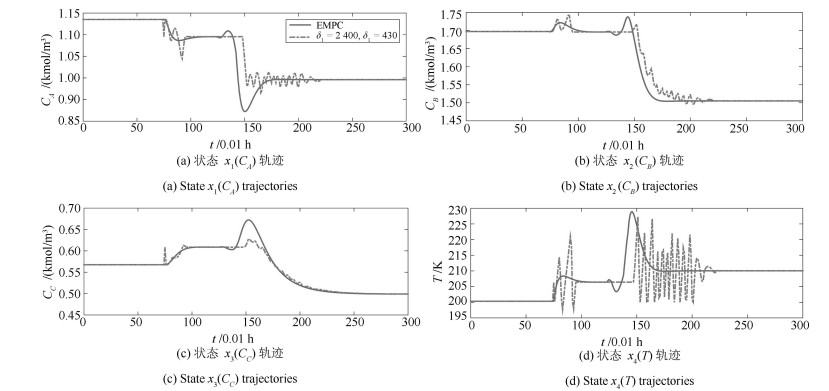
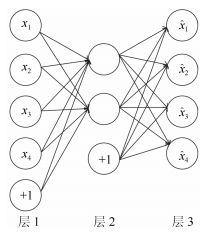
 下载:
下载:




